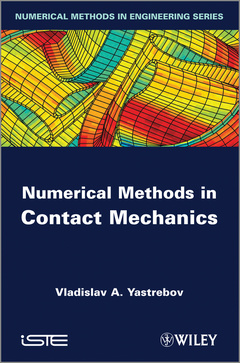Description
Numerical Methods in Contact Mechanics
Author: Yastrebov Vladislav A.
Language: English
416 p. · 16.4x24 cm · Hardback
Description
/li>Contents
/li>Biography
/li>
Computational contact mechanics is a broad topic which brings together algorithmic, geometrical, optimization and numerical aspects for a robust, fast and accurate treatment of contact problems.
This book covers all the basic ingredients of contact and computational contact mechanics: from efficient contact detection algorithms and classical optimization methods to new developments in contact kinematics and resolution schemes for both sequential and parallel computer architectures. The book is self-contained and intended for people working on the implementation and improvement of contact algorithms in a finite element software.
Using a new tensor algebra, the authors introduce some original notions in contact kinematics and extend the classical formulation of contact elements. Some classical and new resolution methods for contact problems and associated ready-to-implement expressions are provided.
Contents:
1. Introduction to Computational Contact.
2. Geometry in Contact Mechanics.
3. Contact Detection.
4. Formulation of Contact Problems.
5. Numerical Procedures.
6. Numerical Examples.
About the Authors
Vladislav A. Yastrebov is a postdoctoral-fellow in Computational Solid Mechanics at MINES ParisTech in France. His work in computational contact mechanics was recognized by the CSMA award and by the Prix Paul Caseau of the French Academy of Technology and Electricité de France.
Foreword xi
Preface xiii
Notations xv
Chapter 1. Introduction to Computational Contact 1
1.1. Historical remark 5
1.1.1. The augmented Lagrangian method 7
1.2. Basics of the numerical treatment of contact problems 9
1.2.1.Contact detection 9
1.2.2.Contact discretization 10
1.2.3.Contact resolution 13
Chapter 2. Geometry in ContactMechanics 15
2.1. Introduction 15
2.2. Interaction between contacting surfaces 19
2.2.1.Some notations 19
2.2.2.Normal gap 21
2.2.3.Closest point on a surface 26
2.2.4.Closest point on a curve 28
2.2.5.Shadow-projectionmethod 32
2.2.6.Tangential relative sliding 35
2.3. Variations of geometrical quantities 38
2.3.1.First-ordervariations 38
2.3.2. Second-order variations 40
2.4. Numericalvalidation 42
2.5. Discretized geometry 44
2.5.1. Shape functions andfinite elements 44
2.5.2. Geometryof contact elements 45
2.6. Enrichmentof contactgeometry 51
2.6.1. Derivation of enriched quantities 53
2.6.2. Variations of geometrical quantities 58
2.6.3.Exampleof enrichment 65
2.6.4.Concludingremarks 68
Chapter 3. Contact Detection 71
3.1. Introduction 71
3.2.All-to-all detection 76
3.2.1.Preliminaryphase 76
3.2.2.Detection phase 79
3.3.Bucket sort detection 84
3.3.1.Preliminaryphase 86
3.3.2.Numerical tests 87
3.3.3.Detection phase 90
3.3.4. Multi-face contact elements 91
3.3.5. Improvements 92
3.4. Case of unknown master–slave 93
3.5.Parallel contactdetection 97
3.5.1.General presentation 97
3.5.2. Single detection, multiple resolution approach 97
3.5.3. Multiple detection, multiple resolution approach 99
3.5.4. Scalability test 100
3.6.Conclusion 101
Chapter 4. Formulation of Contact Problems 103
4.1. Contact of a deformable solid with a rigid plane 103
4.1.1.Unilateral contactwith a rigid plane 104
4.1.2. Interpretation of contact conditions 109
4.1.3.Friction 111
4.1.4.An analogywith plastic flow 117
4.1.5. Interpretation of frictional conditions 121
4.2. Contact of a deformable solid with an arbitrary rigid surface 124
4.2.1. Non-penetration condition 125
4.2.2. Hertz–Signorini–Moreau’s contact conditions 129
4.2.3. Interpretation of contact conditions 130
4.2.4. Frictional conditions and their interpretation 132
4.2.5. Example: rheology of a one-dimensional frictional system on a sinusoidal rigid substrate 133
4.3. Contact between deformable solids 135
4.3.1. General formulation and variational inequality 135
4.3.2. Remarks on Coulomb’s frictional law 142
4.4. Variational equality and resolution methods 144
4.5. Penaltymethod 145
4.5.1.Frictionless case 145
4.5.2. Example 148
4.5.3. Nonlinearpenaltyfunctions 151
4.5.4. Frictional case 153
4.6. Method of Lagrange multipliers 157
4.6.1.Frictionless case 158
4.6.2. Frictional case 161
4.6.3. Example 164
4.7. AugmentedLagrangianMethod 170
4.7.1. Introduction 170
4.7.2.Applicationto contact problems 174
4.7.3.Example 183
Chapter 5. Numerical Procedures 189
5.1.Newton’smethod 189
5.1.1. One-dimensional Newton’s method 190
5.1.2. Multidimensional Newton’s method 193
5.1.3. Application to non-differentiable functions 195
5.1.4. Subdifferentials and subgradients 196
5.1.5 GeneralizedNewtonmethod 200
5.2. Returnmappingalgorithm 203
5.3. Finite elementmethod 210
5.3.1. Introduction 211
5.3.2.Contact elements 216
5.3.3. Discretization of the contact interface 219
5.3.4. Virtual work for discretized contact interface 220
5.3.5.Linearizationof equations 223
5.3.6.Example 225
5.4. Residual vectors and tangent matrices for contact elements 225
5.4.1. Penalty method: frictionless case 226
5.4.2. Penalty method: frictional case 228
5.4.3. Augmented Lagrangian method: frictionless case 237
5.4.4. Augmented Lagrangian method: frictional case 240
5.5. Method of partial Dirichlet–Neumann boundary conditions 248
5.5.1. Description of the numerical technique 248
5.5.2.Frictionless case 250
5.5.3.Frictional case 254
5.5.4.Remarks 255
5.6. Technicaldetails 255
5.6.1. Rigidmaster surface 256
5.6.2. Multi-face contact elements and smoothing techniques 257
5.6.3.Heterogeneous friction 260
5.6.4.Short remarks 261
Chapter 6. Numerical Examples 265
6.1.Two dimensionalproblems 265
6.1.1. Indentation by a rigid flat punch 265
6.1.2. Elastic disk embedded in an elastic bored plane 269
6.1.3. Indentation of an elastic rectangle by a circular indenter 272
6.1.4. Axisymmetricdeepcup drawing 274
6.1.5. Shallowironing 278
6.1.6. Axisymmetric post-buckling of a thin-walled cylinder 279
6.2. Three-dimensionalproblems 286
6.2.1. Accordion post-buckling folding of a thin-walled tube 286
6.2.2. Hydrostatic extrusion of a square plate through a circular hole 288
6.2.3. Frictional sliding of a cube on a rigid plane 292
Appendix 1. Vectors, Tensors and s-Structures 297
A1.1. Fundamentals 298
A1.2.Vector space basis 303
A1.2.1. Transformation matrices, covariant and contravariant objects 306
A1.2.2. Gradient operator or Hamilton’s operator 308
A1.3. Sub-basis, vector function of v-scalar argument 311
A1.4.Tensors 314
A1.5.Tensor as a linear operatoron vector space 322
A1.6.S-structures 325
A1.6.1. Formal definition, notations and types 327
A1.6.2.Simple operations 331
A1.6.3. Invariant s-structures 333
A1.6.4. Scalar products of v-vectors 336
A1.6.5. Inversev-vector 341
A1.6.6. Isomorphism of s-space and tensor space 343
A1.6.7. Tensor product of v-vectors 348
A1.7.Reducedformof s-structures 349
Appendix 2. Variations of Geometrical Quantities 353
A2.1.First-ordervariations 353
A2.1.1.Normal projectioncase 354
A2.1.2. Shadow-projection case: infinitely remote emitter 356
A2.1.3. Shadow-projection case: close emitter 361
A2.2. Second-order variations 362
A2.2.1.Normal projectioncase 362
A2.2.2. Shadow-projection case: infinitely remote emitter 369
A2.2.3. Shadow-projection case: close emitter 370
Bibliography 375
Index 387
Vladislav A. Yastrebov, Postdoctoral-fellow in Computational Solid Mechanics.




